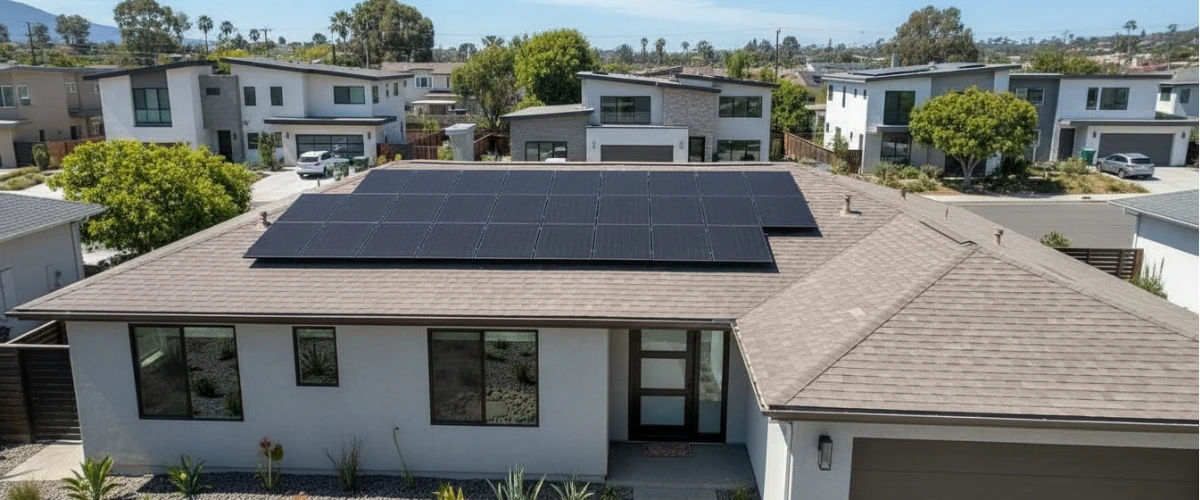Should You Expand Your Solar Panels or Add a Battery

Solar and Roofing Advisor
Confused by NEM 3.0? Find out whether adding panels, installing a battery, or combine panels and batteries to cut high SoCal utility bills with US Power!

If you installed solar more than a few years ago, you may remember exporting excess power to the grid and earning credits at near-retail rates. That era is mostly over. California’s investor-owned utilities (SCE, PG&E, SDG&E) now operate under a Net Billing Tariff (NBT), the successor to NEM 2.0.
Under NBT/NEM 3.0:
- Exported solar is credited back at a rate closer to the utility’s avoided cost, not the full retail rate.
- You are required to be on a time-of-use (TOU) rate that penalizes energy import during peak hours.
- Compensation “adders” for exports (bonus credits) are available but declining and time-limited.
In short: sending power back to the grid is now much less lucrative, especially compared to the value of using solar power yourself during peak evening hours.
Why Batteries Are More Valuable Than Ever
Under today’s NBT rules, a battery isn’t just a “nice-to-have” — it’s a financial lever. Here’s why homeowners (and many Reddit users) are leaning hard into storage:
- Time-shift your solar energy: Store excess power generated by your panels during the day.
- Use that energy when the sun goes down: Especially when electricity rates are highest.
- Avoid low export credits: Instead of exporting to the grid at ~5–8¢/kWh, you use the power yourself — a much higher “value” than the export credit.
- Reduce your grid dependency: Less reliance on the grid during peak hours means lower import costs. Particularly useful in SoCal, where utility peak rates often fall in the evening.
- Future-proof your home: Batteries pave the way for resilience (power outages) and further electrification (EVs, heat pumps).
Several homeowners in similar situations pointed out that battery-first strategies make more sense than just panel expansion:
“If your NEM rules allow … spend your money [on a battery] first. If there is any cash left over, add some panels.”
“You need both … the only way [to cut your bill] in NEM 3.0.”
Should You Add More Solar Panels or Invest in a Battery?
There’s no one-size-fits-all, but here’s a structured way to think through your decision.
1. Evaluate Your Current System & Usage
- Panel count & production: How much are your existing panels producing? Are you exporting a lot or still pulling from the grid in the evening?
- Electricity usage pattern: When is your peak usage? If most of your usage is between 4–9 PM, your evening import might be your biggest cost.
- Utility plan: Confirm whether you’re on NBT / NEM 3.0 and which TOU rate you’re locked into.
- Bills and credits: Look at your monthly electricity bill — how much are you importing vs exporting? What credits are you receiving?
2. Short-Term Budget Constraints
If you’re tight on cash, adding panels first is sometimes more affordable. But if your quotes show high install costs for batteries, negotiate: labor markups tend to be where installers make big margins, as several Reddit users noted.
3. Long-Term Payback & Incentives
- Federal ITC (Investment Tax Credit): As of 2025, you can still claim 30% of your solar + storage system cost if it’s installed before year-end.
- SGIP Storage Rebates: These rebates for battery storage are still available, though funding is limited.
- Property tax exclusion: Solar systems installed before January 1, 2027, are typically not added to your assessed property value.
Given current incentives — and the reduced value of exporting — combining panels + battery usually offers the strongest ROI.
Recommended QCells Panels & Battery Storage Options
Here’s a homeowner‑friendly breakdown of top QCells products that align with these strategies, especially for Southern California homes:
QCells Solar Panels
Q.PEAK DUO XL‑G9.2
- Bifacial, high-efficiency design.
- Great for maximizing production per panel, especially if space is tight.
QCells Full‑Black G10 (460–480 W)
- All-black aesthetic for a sleek, clean roof.
- High wattage output, optimized for residential systems looking for both performance and curb appeal.
Why QCells?
- Long 25-year performance warranty on many models.
- Proven reliability + global track record.
- Works well with a variety of inverters and battery setups for scalable system design.
QCells Battery Storage
If you’re leaning into storage, here are two excellent QCells options:
Q.HOME CORE (Hybrid)
- Includes Q.VOLT inverter (3.8 or 7.6 kW) + Q.SAVE battery modules.
- Modular battery: start with 10 kWh (2 modules) and scale up to 20 kWh.
- LFP battery chemistry for safety and longevity.
- Built-in whole-home backup (200A) capability.
- 12-year base warranty (extendable to 15 years).
Q.HOME CORE G3 (AC-coupled)
- Ideal if you already have solar panels installed.
- Stackable capacity: ~13.1 kWh to ~26.2 kWh.
- 7.6 kW continuous output — supports critical loads.
- High round-trip efficiency (~89–90%) and 15-year product warranty.
Which to choose?
GoalRecommended SetupMax daytime production + nighttime usageQ.PEAK DUO (or Full-Black) + Q.HOME CORE (10–15 kWh)Resiliency / outage backupQ.HOME CORE G3 (13–26 kWh)Future scalability & brand continuityQCells panels + QCells storage (expandable)
For a deeper dive into QCells battery options, see our guide: QCells Home Core and battery storage.
Case Study: Why a SoCal Homeowner Might Choose a Battery Over More Panels
Here’s a breakdown using a real-world scenario (inspired by the Reddit thread):
- Existing system: 8 panels (~455 W)
- Home size: ~1,985 sq ft, family of 4, all-electric
- Monthly bill: ~$185 (despite solar)
- Peak usage hours: 4–9 PM
Analysis:
- Their panel capacity is too small to meet total usage + charge a battery.
- Under NEM 3.0, exporting their daytime surplus yields very low compensation.
- A battery allows them to store excess solar during the day and use it in the evening, significantly reducing import during expensive TOU hours.
Cost‑Benefit (Hypothetical):
Battery-first scenario
- Install a 13 kWh Q.HOME CORE G3: covers evening usage, reduces imports
- Use self-generated power, minimize evening grid purchases
- Apply 30% federal tax credit → strong ROI
Panels-first scenario
- Add 6–8 QCells panels: increase daytime production
- But if excess is exported, credit rate is low → limited benefit unless matched with storage later
- Risk: underutilized production if you don’t use or store it
Conclusion: For this homeowner, battery + modest panel expansion likely delivers the fastest savings and longest-term value.
Common Concerns & How to Overcome Them
“Batteries are too expensive to install right now.”
Totally valid concern. But quotes often include heavy markup on labor. Ask for itemized quotes, get multiple bids, and highlight potential SGIP rebates to your installer.
“What if I don’t consume all the stored energy?”
That’s where smart usage comes in: shifting high-consuming tasks (like water heating or EV charging) to coincide with solar production helps maximize storage use.
“How do I size my system?”
Monitor your usage for at least 6–12 months. Use a tool like Emporia Vue (with sensors) to track when and how you consume power. Several homeowners on forums recommend this as a smart first step.
“Will I lose my grandfathered rate if I upgrade?”
It depends. Under NEM rules, adding capacity may trigger changes — but adding a battery doesn’t necessarily force you off old NEM plans. It’s essential to check with your installer and the utility.
Why Work with US Power
At US Power, we understand Southern California’s energy landscape — especially under NEM 3.0. Here’s how we help:
- Factory-direct QCells panels → lower hardware cost, premium quality
- Expert system design → we size panels + batteries based on your real usage and goals
- Seamless permitting + installation → we handle everything
- Incentive guidance → maximize 30% federal ITC, SGIP rebates, and state exclusions
- Long-term support → monitoring, maintenance, and scaling as your needs grow
Ready to see how a tailored QCells solar + storage system can slash your SCE or PG&E bill? Contact US Power today for a free consultation and quote.
- NEM 3.0’s low export rates make traditional solar payback harder.
- Batteries are now the smartest way to maximize value, helping you store and use your solar energy when it’s most expensive.
- For many SoCal homes, combining panels + storage offers the best ROI — especially with current incentives.
- Choosing QCells panels + Q.HOME CORE or G3 storage gives you a highly reliable, scalable, and efficient system.
- US Power is your partner in making that system a reality — from quote to installation to savings.
Bottom line: If you’re like the homeowner from the Reddit thread — tired of $185+ bills despite having solar — the question isn’t just “more panels or battery?” It’s how to optimize your system for today’s rules. With the right design and trusted products, you can significantly reduce your grid dependence and maximize real savings.
Schedule a FREE Consultation with US Power!
Related Articles
Our Related Blogs
The 30% solar credit ends soon — don’t sign blind. We are here to help you switch!
Rising rates and changing policies are pushing SoCal homeowners to go fully solar.
Avoid delays & damage—learn how to protect your solar investment with US Power.
Our Solar and Roof Brand Partners








We empower communities and businesses to harness clean, renewable solar energy solutions that drive sustainable growth.
Ready to Own Your Power? Call us today!
818-650-8010
Copyright © 2025 US Power - Axia by QCells. All Rights Reserved.
Privacy is important to us, so you have the option of disabling certain types of storage that may not be necessary for the basic functioning of the website. Blocking categories may impact your experience on the website.
Essential
These items are required to enable basic website functionality.
Personalization
These items allow the website to remember choices you make (such as your user name, language, or the region you are in) and provide enhanced, more personal features.
Marketing
These items are used to deliver advertising that is more relevant to you and your interests.
Analytics
These items help the website operator understand how its website performs, how visitors interact with the site, and whether there may be technical issues.
We and our third-party partners use cookies and other technologies to enhance and track your experience on this site, conduct analytics, and personalize marketing to you. By using the site, you agree to our use of these technologies, including recording and monitoring your interactions with the site.
Get an instant solar estimate using satellite!






%20Thumbnail.png)


